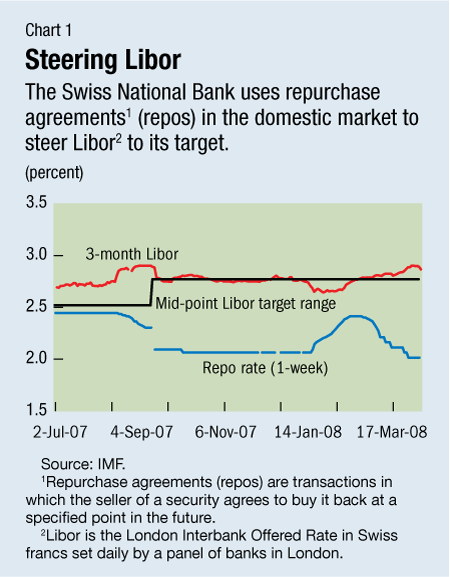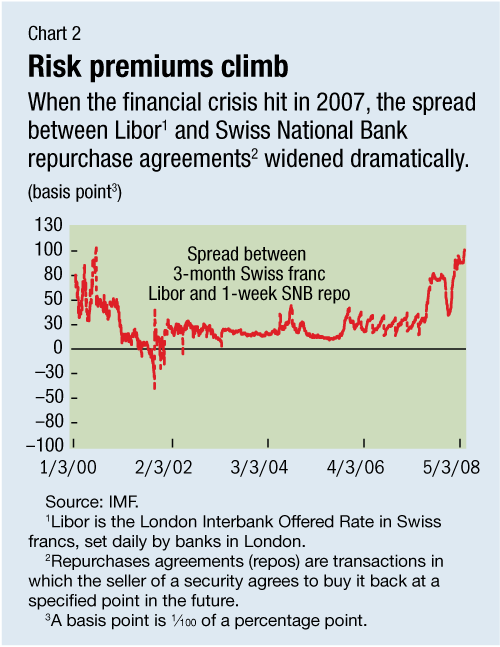
Typical street scene in Santa Ana, El Salvador. (Photo: iStock)
IMF Survey: Distinctive Swiss Monetary Framework Shields Real Economy
July 16, 2008
- Framework has helped shield nonfinancial sector from financial turbulence
- Central bank has calmed main Swiss franc interbank money market
- Framework works well but financial market problems could loom in future
Switzerland's unique monetary policy framework, which targets an interest rate determined in another country, has helped to shield the nonfinancial sector of the Swiss economy from the recent turbulence in financial markets.

Swiss National Bank headquarters: SNB's approach allows policy stance to stay unchanged despite changing money market conditions (photo: Newscom)
INTEREST RATE TARGETING
The Swiss National Bank (SNB) implements monetary policy based upon an explicit definition of price stability—an annual CPI inflation rate under 2 percent—as a long-term anchor, and uses an inflation forecast as the main indicator for monetary policy decisions.
As an operational objective, the SNB announces a target range for the 3-month London Interbank Offered Rate (Libor) for Swiss francs, a rate fixed daily by a panel of banks in London. The SNB attempts to steer the 3-month Swiss franc Libor to the middle of this target range by buying and selling short-term instruments, in particular, one-week repurchase agreements (repos) in the domestic market (see Chart 1). Banks located abroad are also eligible to participate in the SNB's repo operations and a considerable amount of allocated liquidity goes to these foreign institutions.
Why it picked Libor
The SNB chose the Libor as its reference interest rate because it is the main rate at which Swiss franc credit is priced, it is closely linked to Swiss final domestic demand, most Swiss franc derivatives contracted in international markets are priced off Libor, and it cannot be manipulated by individual participants in the market. Moreover, when the framework was introduced in 2000, there was no suitable alternative in Switzerland because the domestic repo market was still developing and large Swiss banks tended to dominate the interbank market.

While the Swiss franc Libor is a nonmarket rate based offshore, as the sole provider of Swiss franc liquidity the SNB has demonstrated it can steer the rate through domestic repo operations.
In contrast, most industrial-country central banks, such as the European Central Bank or the U.S. Federal Reserve, conduct their monetary policies by targeting market-based overnight rates determined in domestic markets.
The SNB developed this operational framework because Switzerland's open economy and the close international ties of its financial center required that the bank have the ability to swiftly adjust to changes in financial markets without having to make adjustments to the monetary stance (target range). The current system allows this because liquidity conditions can be adjusted up or down while the monetary stance indicator—the target range for the 3-month Libor—can remain unchanged.
More flexibility
The Swiss approach imparts a degree of flexibility, which has served it well during the turbulence in financial markets that had its origins in the crisis in U.S. mortgage markets. For example, when a sharp and disorderly repricing of credit risk caused the 3-month Libor to move above the mid-point of the target range just before the SNB monetary policy meeting last September, the SNB at first tolerated the increase.
The SNB acquiesced because the SNB Governing Board was expected to change the policy stance, raising the Libor target because of a worsening inflation outlook. At the September meeting the SNB Governing Board did that, raising the target range by 25 basis points to 2.75 percent. But at the same time, in order to drive the Libor down it lowered the 1-week repo rate by 25 basis points.
Money markets calmed
By partly compensating the increase in banks' funding costs due to higher risk premiums, the move calmed interbank money markets. As risk premiums have ebbed and flowed since then, the SNB has kept the target range constant at 2.75 percent, issued longer-term repos to help banks manage liquidity, and adjusted the 1-week repo rate as needed to keep the 3-month rate near the target.
In this manner, monetary authorities have largely offset gyrations in the risk premium and changes in interest rate expectations in recent months. This has shielded the real economy. Mortgage, prime lending, and other retail interest rates linked to Libor have remained relatively stable.
As the SNB has noted, the operational framework incorporates a sort of "automatic monetary stabilizer," which allowed the policy stance to remain unchanged despite changing money market conditions by using a target interest rate that is tightly linked to final domestic demand instead of a simple overnight interest rate.
Potential hurdles
Recent events have demonstrated the many positive attributes of the SNB framework—in particular, the framework's flexibility to adjust to changing bank refinancing conditions. Nevertheless, they have also highlighted some issues:
• The risk premium inherent in the Libor has become much more volatile since the start of the turmoil last summer: The difference between the 3-month Libor (an unsecured rate) and the 1-week repo (a secured rate) reflects risk and liquidity premiums. This spread remained relatively stable at around 30 basis points as risk aversion declined across markets earlier in the decade. However, it has now increased to about 70 to 100 basis points since the start of the subprime crisis and is more volatile (see Chart 2). The SNB has noted that this volatility makes it harder to steer the Libor.

• Continued lack of liquidity may also affect Libor volatility: Libor is calculated according to what banks perceive to be their unsecured funding costs—in the form of non-binding quotes—rather than reflecting actual market trades. Market participants have questioned whether concerns over banks' creditworthiness have distorted Libor's informational value, particularly in U.S. dollar markets. There is no evidence that Swiss franc Libor does not reflect true market interest rate conditions. However, not all reporting banks have been equally affected by the financial market turmoil, and the liquidity of Libor-based, unsecured money market trading in a crisis is much lower than usual. As a result, the range of reported bank funding costs has been much wider., which can create random fluctuations in Libor.
• Communicating the monetary stance will become more important: Markets appear to understand the SNB framework well. Nevertheless, the September decision to tighten the monetary stance on the one hand while engineering an effective relaxation on the other may have been difficult to understand for non-SNB watchers. The ongoing turmoil in financial markets may require similar adjustments that will need to be well communicated to the market.
Comments on this article should be sent to imfsurvey@imf.org


